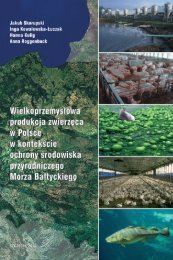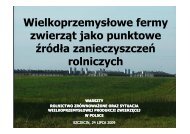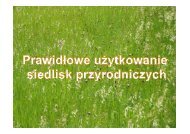best available technologies for manure treatment - Baltic Green Belt
best available technologies for manure treatment - Baltic Green Belt
best available technologies for manure treatment - Baltic Green Belt
You also want an ePaper? Increase the reach of your titles
YUMPU automatically turns print PDFs into web optimized ePapers that Google loves.
Best Available Technologies <strong>for</strong> <strong>manure</strong> <strong>treatment</strong> baltic sea 2020<br />
EXECUTIVE SUMMARY AND RECOMMENDATIONS<br />
logies requires an estimation of the cost efficiency of<br />
the leaching reduction. It is <strong>for</strong> this purpose necessary<br />
to make a few assumptions. In order to rationalise<br />
this as well as to make the comparison and competitiveness<br />
of the various <strong>technologies</strong> more clear, we<br />
have developed five farm scenarios.<br />
A questionnaire was elaborated and trans<strong>for</strong>med<br />
into a digital survey, see Annex F. Members of the<br />
IPPC Technical Working group (Annex G) and<br />
IPPC In<strong>for</strong>mation Exchange Group (Annex H) were<br />
invited to participate in the survey. Ten persons responded,<br />
most of them from the Technical Working<br />
Group.<br />
Interviews were per<strong>for</strong>med with staff at the IPPC<br />
Department at DG Environment, the European<br />
IPPC Bureau and with national responsible authorities<br />
<strong>for</strong> implementation of the IPPC Directive in<br />
Denmark, Poland and Sweden (list of people met in<br />
Annex C). Additional in<strong>for</strong>mation has been sought at<br />
DG Environment and IPPC Bureau web pages.<br />
In<strong>for</strong>mation gathered<br />
We have established a list of more than 40 <strong>technologies</strong><br />
<strong>for</strong> livestock <strong>manure</strong> <strong>treatment</strong>.<br />
The list of livestock <strong>manure</strong> <strong>treatment</strong> <strong>technologies</strong><br />
indicates whether the <strong>technologies</strong> can stand<br />
alone or they can be pre- or post-<strong>treatment</strong>s to other<br />
<strong>treatment</strong>s. For livestock <strong>manure</strong> <strong>treatment</strong>, several<br />
<strong>technologies</strong> are often built together to improve the<br />
technical and economic efficiency of the <strong>treatment</strong>.<br />
The total number of ”IPPC farms” (pigs; sows<br />
and poultry) in the EU-25 is around 16.000. This is<br />
less than 0,1% of the total number of farms in the<br />
EU-25. On these farms, 16% of the total number of<br />
production pigs, 22% of the total number of sows,<br />
and around 60% of the total number of poultry are<br />
kept (2008). There are 1.328 IPPC installations <strong>for</strong><br />
the intensive rearing of pigs in the Member States<br />
surrounding the <strong>Baltic</strong> Sea (Table 7).<br />
The IPPC directive sets no limits regarding emissions<br />
of nutrients from installations <strong>for</strong> the intensive<br />
rearing of pigs, but refers to other Community legislation<br />
to be applied as maximum emission limit vales.<br />
The Nitrate Directive limits the annual amount of<br />
N from livestock <strong>manure</strong> in designated N vulnerable<br />
zones to be maximum 170 kg/ha.<br />
Overall recommendations<br />
The complete list of identified livestock <strong>manure</strong> <strong>treatment</strong><br />
<strong>technologies</strong> has been reduced in different ways<br />
in relation to the specific needs and purposes of this<br />
project. Priority was given to <strong>technologies</strong> with proven<br />
leaching reduction effect that are commercially<br />
implemented, with no apparent negative impacts on<br />
the environment or ethical considerations and with<br />
proven and acceptable economic per<strong>for</strong>mance.<br />
The Project Leader has on basis of reviews, study<br />
tours meetings and discussions <strong>for</strong>mulated the following<br />
recommendations:<br />
Recommended <strong>best</strong> <strong>available</strong> technology<br />
<strong>for</strong> <strong>manure</strong> <strong>treatment</strong> <strong>for</strong> intensive rearing<br />
of pigs, to reduce leaching of nutrients<br />
cost effectively<br />
Anaerobic digestion is the <strong>best</strong> technology <strong>for</strong> the<br />
reduction of N leaching. Digested pig slurry has a<br />
well validated higher field effect, whereby more N is<br />
re-circulated in the agricultural production, and less<br />
is leaching, ultimately to the <strong>Baltic</strong> Sea. Each cubic<br />
metre of pig slurry that is anaerobic digested would<br />
result in around ½ kg less leached N, provided the<br />
digestate is used according a fertiliser plan. The estimate<br />
of ½ kg less leaching is based on a field effect of<br />
digested slurry, which is reported to be 17–30% higher<br />
than non-digested slurry (Birkmose et al., 2007),<br />
but considering as well that the increase in field effect<br />
is in the lower range <strong>for</strong> pig slurry, a conservative<br />
estimate of 10% increase in field effect is used (10%<br />
x 5 kg N per m3 slurry = ½ kg N/m3). Digested<br />
slurry is furthermore much more homogenous and<br />
can be spread on the fields with higher accuracy as<br />
fertiliser, and it better incorporates and binds to<br />
the soil. Break-even <strong>for</strong> the economic per<strong>for</strong>mance<br />
of an anaerobic digestion plant is calculated to be<br />
around € 0,1 per kWh electricity that can be sold,<br />
with a reasonable use of the heat. Anaerobic digestion<br />
plants are found in all target countries, except<br />
Latvia (Birkmose et al., 2007), although two third<br />
of the around 100 plants in the target countries are<br />
found in Denmark. On EU level the target countries<br />
are currently only holding around 2% of the total<br />
number of anaerobic digestion plants. Anaerobic<br />
digestion is internationally a well known technology,<br />
7








